As an Amazon Associate, I earn from qualifying purchases with no additional costs for you.
Red wine is an excellent type of wine for collecting as well as keeping on hand for both cooking and drinking, but it’s essential to know how to store it properly. Without proper storage, red wine can turn into undrinkable vinegar in a hurry.
So, how do you store red wine? Red wine should generally be stored at 52 to 58 degrees, depending on the type of wine. It should be stored in a dark, humid, enclosed room and is best stored on its side so that the liquid can contact the cork to prevent it from drying out. Red wine that isn’t correctly stored will spoil.
Do you want to get into wine collecting but aren’t sure how to keep your red wines at their best? Keep reading to learn more about wine storage and how to store your red wine the right way.
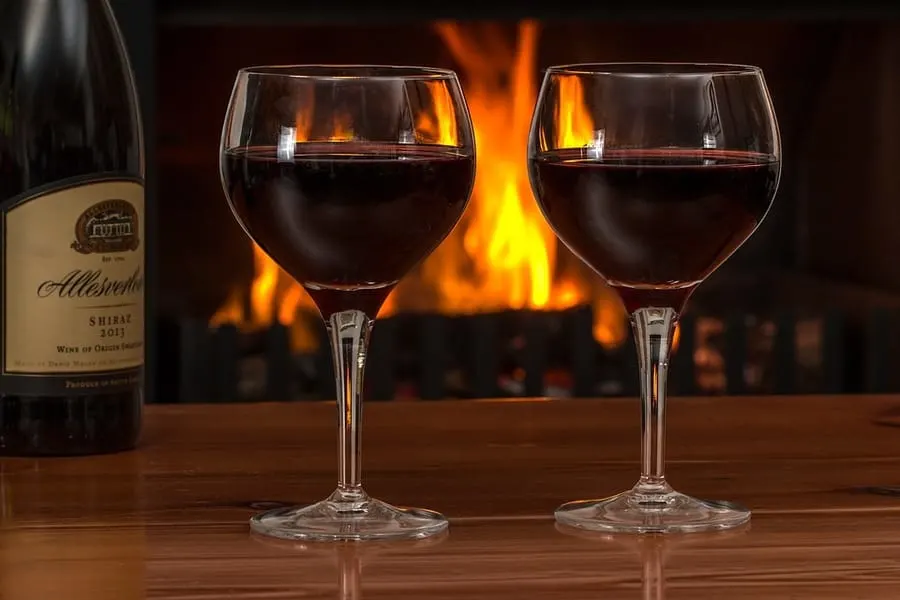
TIP: If you want to check out the best refrigerator for wine storage, I recommend trying out the Avation (18 bottles) compressor refrigerator with Wi-fi smart app control cooling system. You can find this refrigerator by clicking here (Amazon link).
How to Store Red Wine at Home
The way that red wine needs to be stored depends entirely on how long you’re planning on storing it before use. If red wine is intended to be used immediately after purchase, it can be placed in a fridge for chilling.
However, if wine is going to be saved for a later date, it should be kept at just below room temperature, preferably in a wine fridge or wine cellar.
Recommendation box: Everything you need to enjoy your wine as much as possible. All recommended products are personally tested and regularly used by experts from this website (Amazon links):
> Ivation Wine Cooler – Energy-efficient wine cooler for 18 bottles with Wi-fi smart app control cooling system.
> Wine Rack – Beautiful, elegant wood rack for up to 7 bottles and the choice of vertical or horizontal storage.
> Durand Wine Opener – Classic vintage wine opener (we like all these classic staff).
> YouYah Iceberg Wine Decanter – The most beautiful and handy wine decanter we personally use.
> Bormioli Rocco Wine Glasses – A set of eight elegant and traditional wine glasses made in Italy.
> Vintorio Wine Aerator – Simple but really useful wine aerator for a reasonable price.
> The Original Vacu Vin Wine Saver – The best wine saver on the market in a package with two vacuum stoppers and two wine servers.
And if you want to become a true connoisseur of wine, we recommend reading the book Wine Folly: The Essential Guide to Wine (Amazon link), where you will find all the information you need about winemaking, wine varieties, flavors, and much more.
It’s important to remember that different kinds of wines are designed to have different longevities. Everyday red and white table wines—in other words, the types of table wines you see for sale at the grocery store—are not designed to be stored for long periods and will spoil even in a designated wine fridge.
Don’t waste your wine cellar space on subpar wines; you’ll just end up with a bunch of vinegar in a few years.
As opposed to everyday table wines, some vintage red wines are designed to be stored for decades. Here are the qualities that typically dictate whether the wine will improve with age:
- Acidity level: High acidity helps to preserve wine, so the more acidic it is, the more likely it is to age in a palatable way.
- Alcohol by volume: Alcohol acts as a natural preservative, and bacteria find it difficult to cultivate in. For this reason, fortified wine was often added to water in ancient times to make it drinkable when boiling wasn’t feasible.
- Tannins: Since tannin acts as a preservative, the higher the level of tannins in a wine, the more likely it is to age well.
- Complexity: The types of wine chosen for vintage purposes are wines that become more complicated and nuanced with age, while a wine whose flavor profile is relatively flat will not change dramatically over the years.
Sweetness: At higher content levels, sugar can help act as a preservative. This means that some dessert wines age exceptionally well. (Source: 1)
TIP: For a complete breakdown of the ideal conditions for long-term wine storage, check out this helpful article. This complete guide explains how to properly store unopened red wine the right way.
Along with some recommended ways to store red wine, there are also several ways that red wine should never be stored. Here are some situations to be avoided when storing red wine:
- Sunlight: Never store wine in direct sunlight, as the sun’s rays can cause the wine to discolor and develop off-putting flavors. Sunlight can also cause heat damage in rooms that are not temperature controlled, causing the wine to spoil.
- Heat: Wine should never be stored in an area that is exposed to high temperatures, such as the trunk of a car or near a fireplace in the home. These temperature fluctuations can cause the wine to take on an unpleasant sour jam flavor.
- Vibration: Wine shouldn’t be stored near areas of vibration such as aquarium pumps, stereos, washers, dryers, or treadmills. Vibrations can cause subtle chemical reactions in the wine that can cause flavors to become either dull or cloyingly sweet.
Most red wines are forgiving about storage conditions as long as the place that they’re kept is cool, dark, and relatively humid.
How to Store Red Wine for Cooking
Even if you have a wine in the fridge that is beyond the age where it is something you’d want to put in a wine glass, that doesn’t mean you have to pour it out. A wine that has gone over the hill or has started turning into vinegar can still be cooked with. (Source: Bon Appetit)
If you have an unfinished red wine that is older than the 3-5 days recommended for drinking, it can be stored and used for another one to two weeks for cooking purposes since wine and vinegar are both integral ingredients in several dishes.
Here are some of the various ways you can use old wine in cooking:
- To make a vinegary pan sauce
- To marinate dried fruit for a compote or as a condiment
- To braise dark or fatty meats, especially game
Before using old wine for cooking, you should both smell and taste it to ensure that it is still edible. If the wine has developed an unpleasant smell or doesn’t taste at least palatable (if not drinkable), then it probably should be discarded.
One great way to save leftover wine for cooking is to freeze the wine in ice cube trays. These cubes of wine can be stored in the freezer and then added to sauces, soups, stews, and marinades as necessary to add rich and complex undertones of flavor.
TIP: Read this article for more great ideas on using left over red wine. Have you ever wondered if you can mix red and white wines and what happens if you do? Find out here.
How to Store Opened Red Wine
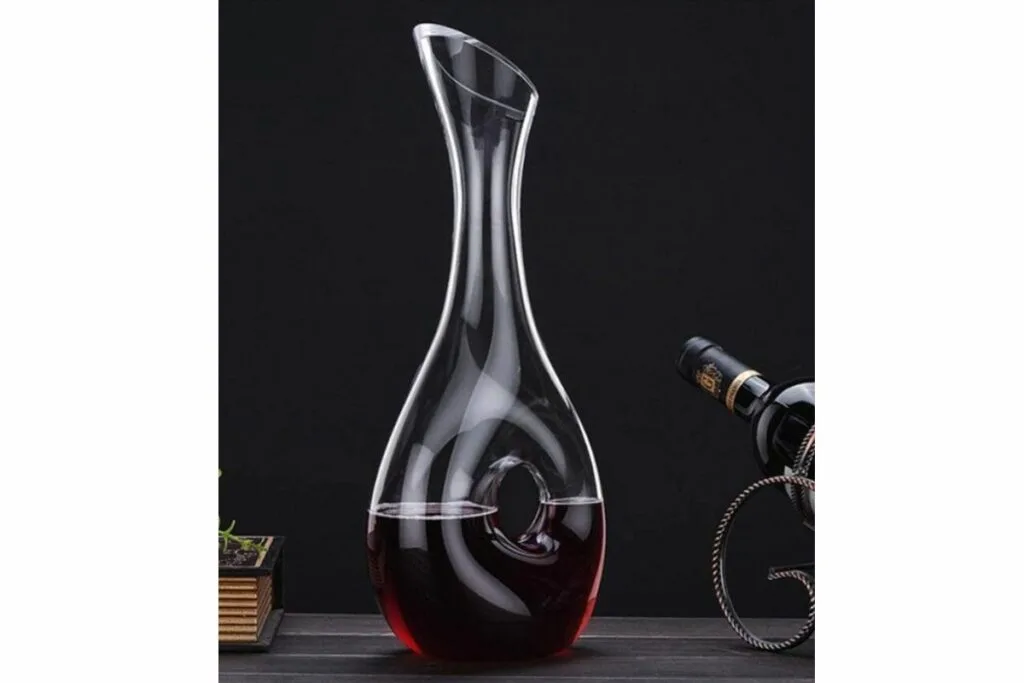
Once you’ve opened your red wine, there are a few ways you can store it to help it last as long as possible in the fridge. Here are some things you should keep in mind to ensure that your red wine lasts:
- Conventional wisdom has stated that the best way to store any red wine is on its side so that the cork can maintain contact with the wine, but a few decades ago, this long-standing theory was challenged. According to research from 2005, scientists discovered that the inside of a wine bottle maintains 100% humidity whether the wine is touching the cork or not
- As far as temperature goes, red wine should ideally be stored at 52-58 degrees, somewhat below room temperature. This means that wine is best stored in either a wine-specific fridge or a wine cellar. Wine can be stored at room temperature, but any fluctuations can have adverse effects on flavor and taste.
- Opened red wine can be stored for approximately three to five days, depending on how many tannins are present in the wine and how acidic it is. The more tannins a wine has and the more acidic it is, the longer it will last—both these qualities help protect red wine against oxidation that ages white wine more quickly. It also depends on the wine being corked after opening.
- Any wine that becomes too old to drink can be transferred into a “dump bucket”—a sealed Mason jar of wine that can be used to store old wine for cooking so that it can still be used. Aged wine that has too much vinegar to drink can still be used.
- Never store wine in anything other than an airtight container, and never leave uncorked wine in the fridge. Oxidation causes a wine to turn into vinegar, and while red wine can last up to five days in the fridge if it is corked, it won’t last more than a day or two without going bad if you don’t seal it up.
Making red wine last as long as possible comes down to storing it properly. The better it’s stored, the longer it’ll stay good. It’s a good idea to invest in some rubber wine stoppers in case you run into a bottle of wine where the wooden cork is damaged in the unbottling.
A major advantage of rubber wine stoppers is that they prevent the wine from both oxidizing and leaking, even when stored in a horizontal position.
TIP: Are you interested in buying a wine stopper? We’ve personally tried and recommend buying one of these wine stoppers (Amazon links):
- The Original Vacu Vin Wine Saver: Our top choice. Very easy-to-use wine stopper/saver. You can enjoy a glass of fresh wine whenever you want without worrying about wasting any.
- EZBASICS Wine Saver: Great alternative to Original Vacu Vin Saver. This wine stopper keeps the flavor of wine for up to one week.
- Champagne Stopper by MiTBA: Wine stoppers for sparkling wines are different. This wine stopper seals your bottle and increases the pressure so your beverage’s bubbles won’t go to waste.
What is the Best Wine Fridge for Red Wine?
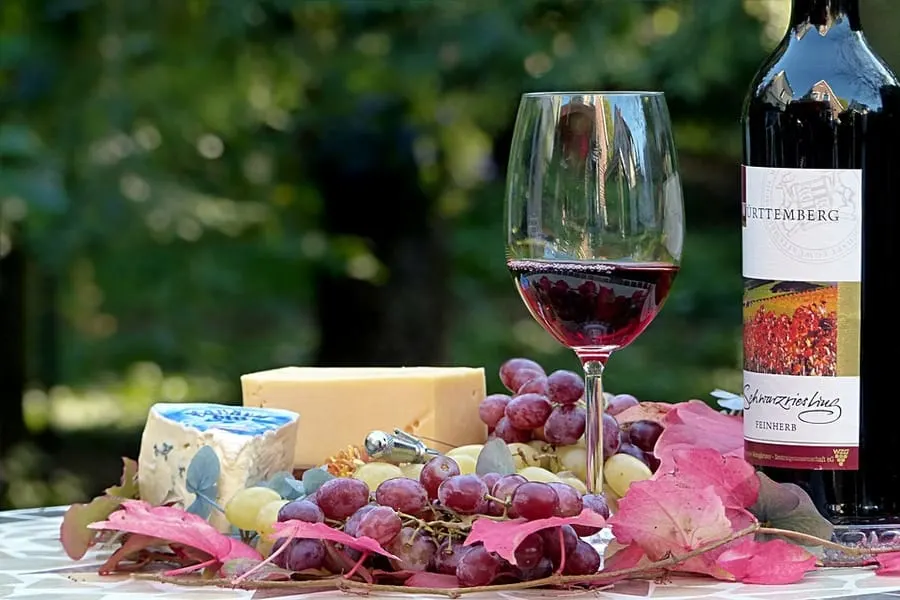
One of the best ways to keep red wine fresh is to keep it in a wine fridge, a specially calibrated fridge that is explicitly designed to store wine.
Here are some of the things that differentiate a wine fridge or wine cooler from a regular kitchen refrigerator:
- Temperature: Wine coolers are set to a slightly higher temperature than standard fridges, which are designed to keep the food inside both dry and cool. The advantage of a wine cooler is that it is calibrated precisely to the ideal temperature of the wine inside, and many wine coolers can be fine-tuned for the type of wine inside.
- Humidity: Wine should be kept somewhat humid to maintain its best color, aroma, and flavor, while traditional fridges are designed to reduce humidity. Wine coolers are designed to maintain humidity, keeping wine in a humid environment that is geared towards its longevity.
- Vibration: Vibration can dull the flavors of wine while simultaneously making it sweeter, meaning that the more complex and nuanced flavors of wine can be ruined by the vibrating compressors in a traditional refrigerator. Wine coolers and wine fridges are designed with shock-absorbing technology that prevents the wine from being disturbed by vibrations.
- Storage: While standard fridges only have a few shelves that can easily hold wine bottles, a wine cooler or wine fridge is designed to hold only wine, which means that many more bottles of it can be stored inside than in a regular kitchen fridge.
- Display lighting: While most kitchen refrigerators are opaque by design, wine coolers or fridges are designed to display wine in an aesthetically pleasing way as well as store it in a temperature-controlled environment. Most wine coolers have low blue lighting rather than white lighting since UV exposure can cause the wine to age more quickly.
Since many smaller wine coolers are reasonably priced, they are well worth the cost of installation if you enjoy wine and want to keep several bottles at the ready without dedicating the space to a full wine cellar. It all depends on the amount of time and resources you want to put into your wine-tasting hobby.
TIP: Most wines go bad once you pop the cork within a day or so. But a Coravin Wine Preservation system (available for a great price on Amazon) can extend the life of your opened wine for weeks or even months. It is awesome. You should check it out to see if it fits your lifestyle.
Best Wine Fridges of 2020
If you want to invest in a wine fridge to increase your wine storage capacity, there are plenty of fantastic units on the market available in a range of prices and functions.
Here are some of the best red wine fridges available (Amazon link):
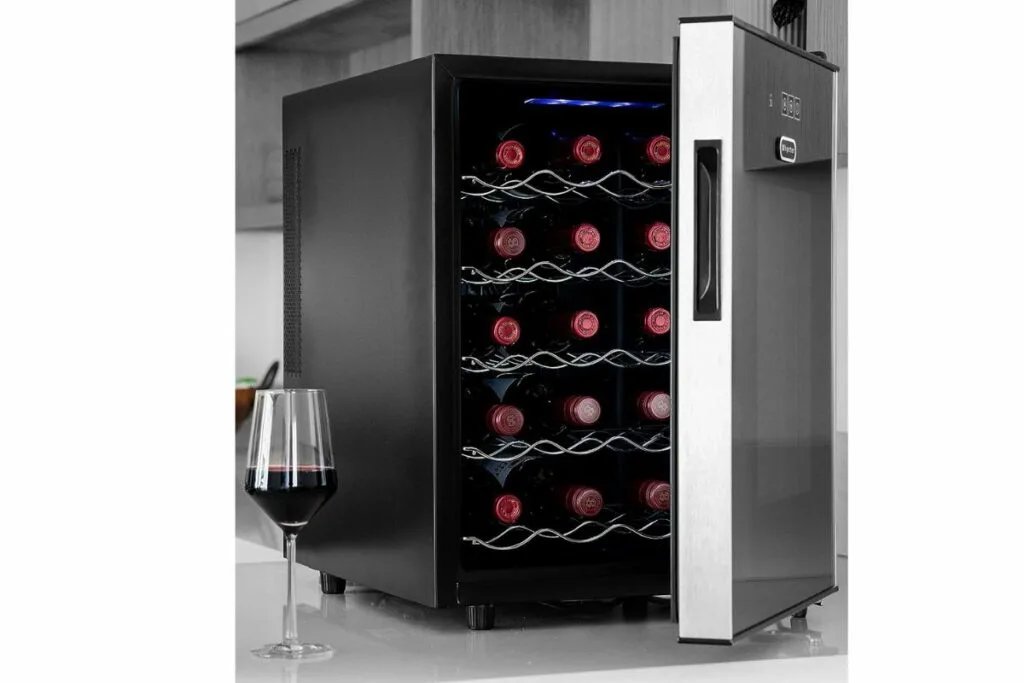
- Whynter 20 Bottle Thermoelectric Wine Cooler with Black Tinted Mirror Glass Door: This sleek-looking wine cooler features an interior light that shows you how many bottles of wine you’re stocking as well as a digital thermometer that ranges between 46 and 65 degrees Fahrenheit. This cooler also has removable shelves so that you can rearrange it however you like.
- Aobosi 30 Bottle Wine Refrigerator: This low-vibration unit has touchscreen control and a clear front display and ventilation system for maintaining both consistent temperature and humidity. A great feature of the Aobosi is its temporary memory feature, which allows the fridge to return to its previously programmed temperature if power is temporarily lost. This prevents a fluctuation in temperature that might hurt more expensive wines.
- Nutrichef PKCWC120 Refrigerator: The NutriChef is a smaller wine fridge since it only holds twelve wine bottles, but its compact size means that it can fit more easily into smaller rooms and spaces. The small size means that it can fit on a table or countertop as easily as it can fit on the floor. The temperature on this wine fridge can be controlled between 41 and 64 degrees Fahrenheit.
- Antarctic Star 24 Bottle Wine Cooler/Beverage Cabinet: For people who are looking for versatility in their wine cooler, the Antarctic Star allows users to store both wine and other beverages such as sodas or beers. This is a near-silent freestanding unit with a soft blue interior light that provides a cool aesthetic without exposing the wine to UV rays.
- Kalamera 30 Bottle Built-in or Freestanding Wine Cooler: This wine cooler can hold wine bottles of several different sizes and is easy to set at any temperature between 40 and 66 degrees. This allows the wine cooler to be set at either storage or chilling temperatures. The compact design of this cooler makes it a terrific drop-in upgrade for old garbage disposal or similar appliance.
Which wine cooler you buy will ultimately depend on several factors such as your budget, the amount of wine you intend to store at any given time, and whether you want a freestanding or a built-in unit. Either way, there are plenty of top-rated models on the market to choose from.
One reason to invest in a wine cooler rather than a full wine cellar is that if you’re renting or plan on moving soon, a wine cooler is easily taken with you, while any wine cellar renovations will have to be left behind as equity.
Wine Fridges vs. Kitchen Fridges
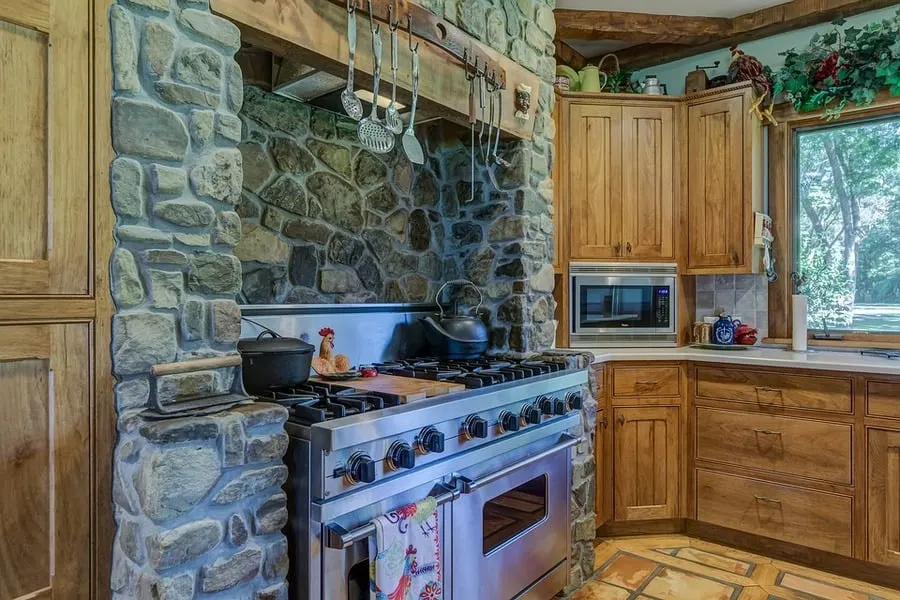
Wine fridges don’t get as cold as kitchen fridges, but they do get cold enough to preserve red wine and prevent it from being damaged by heat. Other than oxidation, heat is the one factor that can seriously damage the flavor of a wine.
An advantage of wine coolers not getting as cold as regular fridges are that they prevent the bottles from freezing, which can potentially cause the wine bottles to crack. Wine fridges are usually smaller than a traditional fridge as well, which makes it easier to fit them into auxiliary rooms such as game rooms, garages, and bars.
Even if you only keep half a dozen or so wines on hand at a time, it’s worth keeping them in a wine fridge to extend their lives as long as possible.
Wine Serving Temperatures for Red Wine
While red wine should be stored at 52 to 58 degrees, it should be allowed to come slightly up to room temperature before serving. On average, red wine should be served at 60 to 68 degrees, or slightly below room temperature. This temperature can vary slightly depending on the acidity of the wine.
Here is a general guide on what temperature to serve specific types of red wine:
- Merlot: 60-65 degrees Fahrenheit
- Pinot noir: 55-60 degrees Fahrenheit
- Cabernet Franc: 60 degrees Fahrenheit
If red wine is generally held at room temperature, it can be added to a wine chiller to be chilled just before serving. Adding wine to the wine cooler for 45 to 90 minutes before serving can bring it down to the optimal serving temperature.
However, wine shouldn’t be held at room temperature if the room temperature fluctuates between
70-75 degrees. Even this slightly higher temperature in an air-conditioned home can cause severe flavor degradation over time, which is one of the reasons that proper storage of wine is so important in preserving it. (Source)
Storing Cheap Wine vs. Expensive Wine
There’s no issue with buying cheap wine if you’re just looking for something to fill out a weekday meal—not every glass of wine has to be something special. However, the price of wine does ultimately say a lot about how long it will last. Cheap wine can’t be stored as long as expensive wine.
How Long Can You Store Cheap Wine?
Cheap table wines or the wines designed for everyday use can’t be stored well over time—most of these wines will go to vinegar after a year or two. No matter how well you store cheap wine, it isn’t designed to last longer than that.
How Long Can You Store Expensive Wine?
Expensive wine (also known as fine wine) is usually made in such a way that it is only improved with age, rather than becoming spoiled.
Fine wines are created from top-tier grapes that are grown in specific conditions and are made to be stored and passed down over decades rather than just a few years. Even the longest-lived wines only live to be around twenty years old at most, however.
TIP: Is there really a difference between cheap and expensive wines? Find out here! This guide discusses the myths around storing wine. Read it to find out the truth!
Wines can be kept longer than twenty years, but at this point, the wine isn’t that drinkable anymore. However, that doesn’t stop people from spending millions of dollars buying centuries-old wine as vintage antiques. (Source: The Guardian)
Storing Red Wine at Room Temperature
If you don’t have room in your kitchen fridge and you don’t have a wine cooler, there’s no need to despair—you can still keep the wine in good condition at room temperature as long as you drop the temperature of your air conditioning system to less than seventy degrees.
TIP: Read this guide to find out how long can you store wine in a carafe. Find out which wines should be served at room temperature here.
Another factor to consider is humidity. If you’re planning on storing wine at room temperature in the house, it’s probably a good idea to invest in a good cool mist humidifier. This will increase the general humidity of the room to closer to 70%, which is the ideal humidity to store wine.
TIP: A suitable wine glass is the basis for enjoying well-being while drinking your favorite wine variety. Here are our favorite ones (Amazon link):
- Bormioli Rocco Crystal Wine Glasses: A set of eight elegant and traditional wine glasses made in Italy for a reasonable price.
- Riedel VINUM Wine Glasses: Luxury set of two wine glasses suitable for any occasion. We just love them!
- Schott Zwiesel Tritan Crystal Glasses: If you like unusual alternatives, a set of six stemless glasses made of crystal glass.
Storing Red Wine in Wine Cellars
If you want to start an extensive collection of fine wines, you can always invest in building a wine cellar. A good place for a wine cellar in the home is a finished basement since this is an area of the home which is naturally cool and humid.
A wine cellar can add significant value to your property, and it can also be a significant investment in money, time, and resources to install as a remodel.
Adding a wine cellar to a home can run an average of forty thousand dollars. (Source: Home Advisor) Needless to say, this is a storage option only for the most serious of wine collectors.
For those who can’t invest the money in a full wine cellar remodel, a makeshift wine cellar can be created in the basement or elsewhere in the home by installing amenities designed to mimic the conditions of a wine cellar such as air conditioning and high humidity control.
Red Wine Can Be Stored in Different Ways
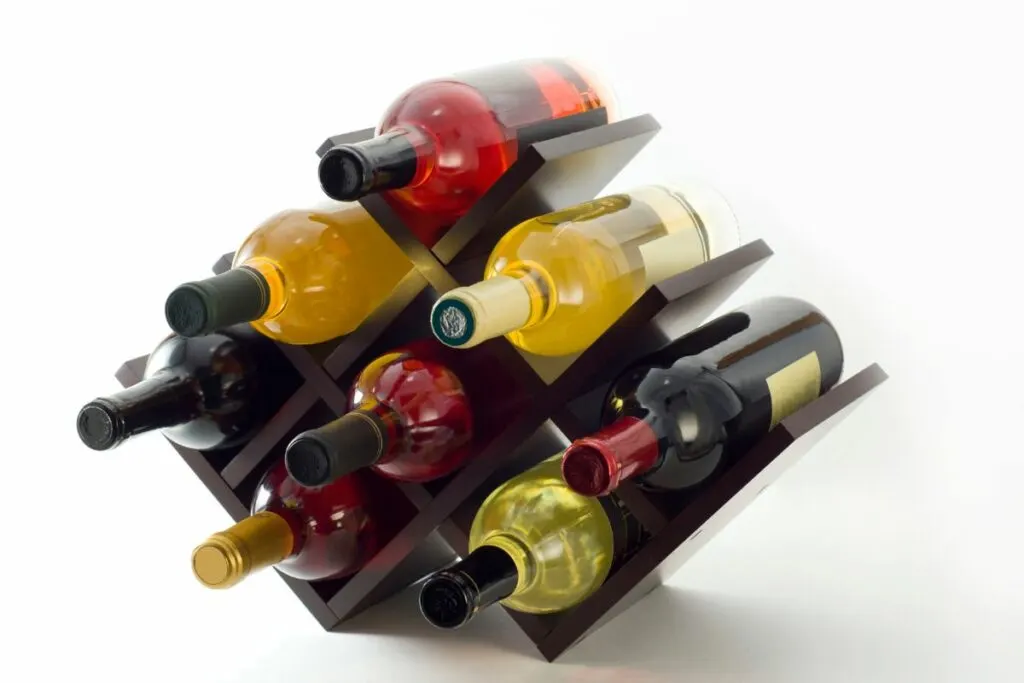
Whether you’re wanting to put away a fine wine for a special occasion twenty years in the future or just want to know how to store your table wine to prevent it from spoiling, red wine needs to be stored in a cool, humid place.
If you only buy red wine occasionally, you can probably get away with storing your wine in a kitchen fridge. However, if you want to keep wine at its optimal quality either for the short term or the long term, wine coolers are well worth the investment.
TIP: Check out this page for a complete list of wine products and accessories I love. You’ll find my recommendations for wine refrigerators, decanters, and aerators and the best place to buy wine online. Click here to see the complete listing.
